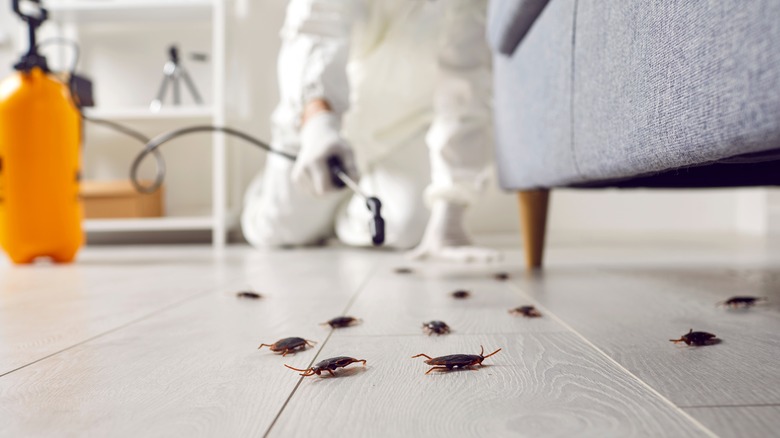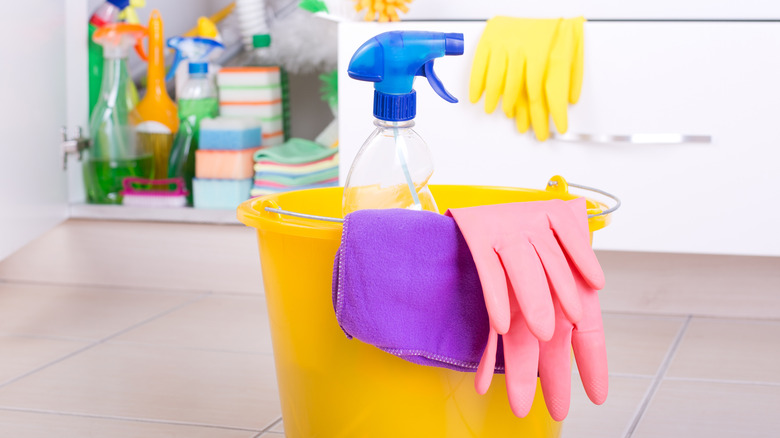Say Goodbye To Pantry Pests With These Easy Tips
For many of us, a change in temperature signals that it's time to clean house — dust off the cobwebs, sort through the accumulated masses, and freshen up. These days, everyone is paying particular attention to their pantry.
Of course, sometimes life offers more obvious signs than a season change to let you know that you need to get some cleaning done. Like, say, if the fruit bowl on the kitchen counter is hosting a raging spring break party for 200 young fruit flies. Or if you notice "Ratatouille" is being put on as a live performance in your kitchen. That's right, we're talking about pantry pests. Everyone gets them, but still, wouldn't it be helpful to know how to deal with an infestation beyond freaking out, jumping on the nearest highest surface, and screaming at the top of your lungs? (Like, something actually useful.) Or better yet, what you can do to try and prevent them from showing up in the first place? Last year, we spoke to Dr. Jim Fredericks, chief entomologist for the National Pest Management Association, to gather some advice on pantry pest management.
Familiarize yourself with the players and their MOs
Generally speaking, the most common pantry pests include various types of beetles, Indian meal moths, ants, cockroaches, rodents, and fruit flies, with flours, dry cereals, spices, candies, fruit, and chocolate serving as some of the biggest targets. According to Fredericks, beetles specifically like cake mixes, macaroni, cookies, and chocolate; Indian meal moths tend to go for your dried fruits, grains, seeds, nuts, bird seed, dog food, dried red peppers, and candy. Ants, he says, "love a good spill or crumb, especially if it's sweet."
Fruit flies, as the name would suggest, are attracted to fruit, specifically of the fermenting (rotting) or fermented variety (a.k.a. wine). "They are able to detect the yeast produced by fermenting fruit, even fruit great distances. Once they have identified an intended target, they have little trouble getting to it as their tiny size allows them to enter a home through minuscule cracks and crevices. Most window screens won't deter them either."
All critters may gross you out, but only some will actually make you sick
Dr. Fredericks says you don't have to sweat about getting sick from beetles or Indian meal moths, but that cockroaches and rodents can transmit dangerous diseases and contaminate food. "Cockroaches can spread 33 kinds of bacteria including E. coli and salmonella. Plus they are known to cause allergic reactions and trigger asthma attacks, especially in children." Rodents, on the other hand, increase the risk of house fires by chewing through electrical wires and insulation as well as carry fleas and mites into the house.
Beware the rapid multipliers
While no pest infestation is "easy" to deal with, obviously, the critters that reproduce more quickly can be even more challenging to deal with and definitely require immediate attention from a licensed professional. As Dr. Fredericks explains, "A mouse problem should be handled by a professional as mice are capable of producing up to 12 babies every three weeks. This means that if you spot one mouse scurrying across the kitchen floor, there are likely more nesting close by." He also calls out ants and fruit flies for their tendency to travel in large numbers. Female moths can apparently lay up to 200 eggs in or near a food source in a mere week, whereas fruit flies lay a staggering average of 500 eggs on the surface of fermenting fruit. Talk about the wrong kind of baby boom, am I right?
Keep a lid on It
One of Dr. Fredericks' top tips for deterring a pantry pest infestation? Arm your kitchen with proper storage. "Invest in some Tupperware-type contains with secure lids. Anything made of plastic or glass works well as long as the storage item comes with a tight-fitting lid."
If you're looking for a cost-effective solution, I recommend doing as the chefs do: Order a couple of sleeves of quart and pint-sized deli containers to keep on hand at all times. They may not make the cutest storage display for your kitchen but they get the job done.
Give your groceries a good once-over
(Not so) fun fact: According Dr. Fredericks, "most pantry pests are brought into the home from items that are already infested, such as food in paper grocery bags, cardboard, or plastic bags." He recommends inspecting all of your desired purchases thoroughly before tossing them into the shopping cart and, obviously, tossing aside any items that look even the slightest bit damaged. It's not worth the risk of introducing fruit flies to your kitchen.
Mind the fresh fruit display
Keeping a bowl of fresh fruit on the counter is a nice look, but if you're going to do it, just make sure you're checking the pieces frequently for signs of over-ripening or decay. (Remember that tidbit about how quickly fruit flies reproduce?) If you know you won't have time to keep a close eye on them, fake fruit or fresh flowers will be better options to add seasonal touches to your kitchen.
Rotate a good scrub-a-dub-dub into your cleaning routine
Practicing good sanitation (aka immediately cleaning up spills and crumbs; disposing of your garbage regularly) helps keep pests at bay — that's a no-brainer. But Dr. Fredericks also recommends that you periodically empty out the cupboards and give them a good scrub down with soap and water. Also, eliminate all leaky moisture sites and seal cracks. "Look for any cracks or holes where pests might be coming into your home, especially around stovepipes and water pipes."







